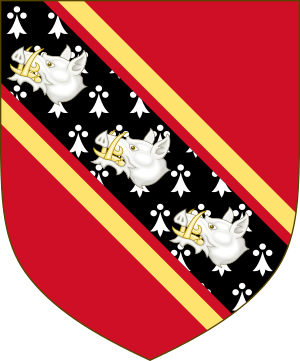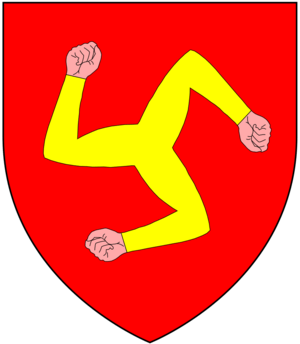Richard Edgcumbe (died 1489) facts for kids
Sir Richard Edgcumbe (around 1443 – 8 September 1489) was an important English courtier and a Member of Parliament. He lived at Cotehele in Cornwall. He played a key role during a very exciting time in English history, helping a new king come to power.
Contents
Family History
Sir Richard Edgcumbe was the son of Piers Edgcumbe and Elizabeth Holland. His family's name, Edgcumbe, came from a place called Edgcombe in Devon, where they lived way back in 1292. Later, one of his ancestors, William Edgcombe, married a woman who owned Cotehele. This is how the family moved to this beautiful home in Cornwall.
Sir Richard's Career
Sir Richard was a Member of Parliament (MP) for Tavistock from 1467 to 1468. This meant he helped make laws for the country.
A Time of Trouble
England was in the middle of a big fight between two powerful families, the Lancastrians and the Yorkists, who both wanted the throne. This was known as the Wars of the Roses. Sir Richard supported the Lancastrians. In 1471, the Yorkist King Edward IV took away Sir Richard's lands, but he got them back the next year.
Escape from Danger
In 1483, Richard of Gloucester took the throne unfairly. People also whispered that he might have harmed the young King Edward V and his brother. Sir Richard Edgcumbe was very upset by this. He joined a rebellion led by the Duke of Buckingham to try and remove Richard III. They wanted Henry Tudor, a Lancastrian, to become king instead.
When the rebellion failed, Henry Tudor had to escape. Soldiers were sent to arrest Sir Richard. He hid on a wooded hillside near his home at Cotehele, which is by the River Tamar. When the soldiers found his hiding spot, he quickly thought of a clever trick. He filled his cap with stones and threw it into the river. The soldiers thought he had drowned and stopped looking for him! This allowed him to escape certain capture and likely death.
Joining the New King
After his escape, Sir Richard fled to Brittany (a region in France). There, he joined Henry Tudor. In 1485, they returned to England. They fought and won the Battle of Bosworth. This victory made Henry Tudor the new King Henry VII. Sir Richard was made a knight that same year for his loyalty and bravery.
Under the new king, Sir Richard held many important jobs. He was an MP for Tavistock again in 1485. He also became a Privy Councillor, which meant he advised the King. He was in charge of the King's household as the Comptroller of the Royal Household. In 1487, he became the Sheriff of Devon, and he even served as an Ambassador to Scotland, helping with important talks between countries.
Mission to Ireland
In 1488, King Henry VII sent Sir Richard on a very important mission to Ireland. A rebellion had just been crushed, and many Irish nobles had supported the rebels. Sir Richard's job was to make these nobles promise their loyalty to King Henry. He was helped by John Payne, the Bishop of Meath, who had once been a rebel himself but was now loyal.
Sir Richard was very smart about how he handled things. He accepted the promises of loyalty from Gerald FitzGerald, 8th Earl of Kildare, who was the most powerful noble in Ireland. It was important to have Kildare's support. But Sir Richard also showed he was fair and firm. He refused to pardon some of the worst rebels, even when Kildare asked him to. He made sure to be friendly and approachable, even dining with important people like the Recorder of Dublin.
Death and Burial
Sir Richard Edgcumbe died on 8 September 1489 in Morlaix, France. He was there on a diplomatic mission to make a peace agreement with Anne, Duchess of Brittany. He was buried in Morlaix, but sadly, his tomb was destroyed much later during the French Revolution.
Family Life
Sir Richard married Joan Tremayne. Her family was from Collacombe in Devon. Together, they had one son and four daughters:
- Sir Piers Edgcumbe (1468/9-1539) was their son and heir. His son, also named Sir Richard Edgcumbe, built the famous Mount Edgcumbe House in Cornwall. The family moved there from Cotehele. Today, the title of Earl of Mount Edgcumbe still exists in the family.
- Agnes Edgcumbe married William Trevanion.
- Margaret Edgcumbe married Sir William St Maur, and later Sir William Courtenay.
- Elizabeth Edgcumbe married Wymond Raleigh.
- Joan Edgcumbe married Fulk Prideaux.




